On Thursday, Amazon unveiled its latest initiative targeting Prime members with fixed pricing for various health treatments. This move aims to carve out a niche in the competitive direct-to-consumer healthcare market, traditionally dominated by companies like Hims & Hers Health and Ro. Such a strategy could potentially disrupt the established players in this space, as evidenced by Hims & Hers experiencing a significant share drop of 17% following Amazon’s announcement. By offering transparent pricing for services related to erectile dysfunction, hair loss, and anti-aging treatments, Amazon hopes to simplify the decision-making process for consumers seeking healthcare solutions.
Amazon’s approach involves providing patients with upfront costs for telehealth consultations for five prevalent health concerns. For instance, anti-aging skincare treatments start at a competitive price of $10 per month, while services for erectile dysfunction are priced at $19 monthly. The transparency in costs might encourage more users to explore telehealth options without the fear of unexpected expenses. Moreover, Amazon has positioned its pricing structure strategically to appeal to Prime members, further incentivizing subscriptions to its retail ecosystem.
With this initiative, Amazon embraces the telehealth model that has gained traction in recent years, especially since the pandemic heightened the demand for remote healthcare services. The company has expanded its offerings to include treatments for over 30 common conditions, such as sinus infections and pink eye. This extensive range enhances Amazon’s appeal as a healthcare provider, especially as it complements the faster delivery of medications via Amazon Pharmacy, which has become increasingly convenient for consumers.
Nevertheless, Amazon’s journey into healthcare hasn’t been entirely smooth. The company launched an online pharmacy in 2020 following its acquisition of PillPack in 2018. While this was a notable advancement, other ambitious healthcare ventures, like the telehealth service Amazon Care, have been discontinued. Furthermore, attempts to develop an at-home fertility tracker were also abandoned. Such developments indicate that while Amazon is keen on establishing a robust presence in healthcare, its path is fraught with challenges and missteps.
As Amazon continues to innovate within the healthcare space, the company’s recent announcements are likely just the tip of the iceberg. The strategic move towards fixed pricing and telehealth further solidifies its commitment to making healthcare services more accessible and affordable. However, whether Amazon can capture significant market share from established competitors remains to be seen. Observers will be watching closely to see if the company’s healthcare initiatives can succeed without the turbulence that has marked its previous attempts. The landscape of healthcare startups is constantly evolving, and how Amazon adapts to these changes could redefine the industry.
Amazon’s recent foray into fixed pricing for telehealth services reflects its broader ambition to revolutionize healthcare. By leveraging its vast logistical network and dedication to customer transparency, the retail giant is set to make significant inroads, although it must navigate the complexities of the healthcare sector with caution and savvy.

